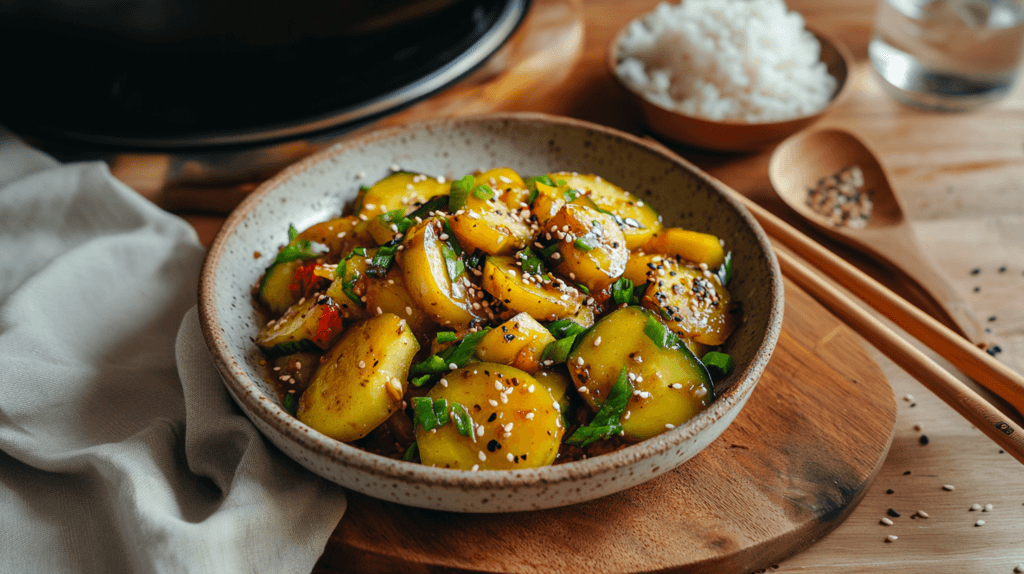Introduction to Easy Chinese Squash Recipes Kabocha Vegan

Easy Chinese squash recipes kabocha vegan combine the rich flavor of kabocha squash with the healthy, plant-based principles of vegan cooking. Kabocha squash, also known as Japanese pumpkin, has a sweet and nutty taste that works well in Chinese-inspired dishes. These recipes are perfect for those seeking a flavorful, nutritious, and cruelty-free dining experience.
This article explores how kabocha squash complements Chinese vegan cuisine. We’ll dive into its health benefits, essential ingredients, and step-by-step preparation methods. Whether you’re a seasoned cook or a beginner, you’ll find valuable tips to create your own delicious recipes.
Health Benefits of Kabocha Squash
Kabocha squash is not only delicious but also packed with nutrients. Its health benefits make it a star ingredient in easy Chinese squash recipes kabocha vegan:
- Rich in Vitamins and Minerals: High in vitamin A, which supports vision and immune health. It also contains vitamin C, potassium, and magnesium.
- Low in Calories: Despite its sweet flavor, kabocha squash is low in calories, making it ideal for weight management.
- High in Fiber: Promotes digestive health and keeps you feeling full longer.
- Antioxidant Properties: The squash’s beta-carotene content fights free radicals, protecting your body from oxidative stress.
Including kabocha squash in your diet enhances your nutrition while delivering a delightful taste in every bite.
Chinese Squash and Its Role in Vegan Cuisine
Chinese cuisine emphasizes balance, making it an excellent match for kabocha squash. Vegan Chinese recipes highlight vegetables as the main attraction, allowing natural flavors to shine. Here’s why kabocha squash plays a vital role:
- Versatility: Its creamy texture works well in soups, stir-fries, and steamed dishes.
- Flavor Compatibility: The natural sweetness of kabocha squash balances the umami of soy sauce, sesame oil, and fermented black beans.
- Nutrient Density: Chinese cooking often focuses on health, and kabocha squash aligns perfectly with this philosophy.
- Color and Presentation: Its vibrant orange flesh enhances the visual appeal of any dish.
When creating easy Chinese squash recipes kabocha vegan, this ingredient adds depth and authenticity to the cuisine.
Essential Ingredients for Easy Chinese Squash Recipes
To craft authentic easy Chinese squash recipes kabocha vegan, stock up on these essential ingredients:
- Kabocha Squash: The hero of your dish, providing sweetness and richness.
- Soy Sauce: For a salty, umami kick. Opt for low-sodium if preferred.
- Sesame Oil: Adds nutty aroma and depth.
- Garlic and Ginger: The aromatic base for many Chinese recipes.
- Spring Onions: Adds a fresh, mildly spicy flavor.
- Rice Wine or Vinegar: Enhances tanginess and depth.
- Vegetable Stock: A flavorful liquid base for soups and braised dishes.
- Tofu or Tempeh: For added protein.
With these staples, you’re equipped to create a variety of easy Chinese squash recipes kabocha vegan that are both delicious and nutritious.
Step-by-Step Guide to Preparing Kabocha Squash for Cooking
Preparing kabocha squash may seem daunting, but these steps make it simple:
- Wash and Dry: Rinse the squash thoroughly to remove dirt. Pat it dry with a clean towel.
- Cut Safely: Place the squash on a sturdy surface. Use a sharp knife to cut it in half. Be cautious, as the skin can be tough.
- Remove Seeds: Scoop out the seeds and fibrous strands with a spoon. Save the seeds for roasting if desired.
- Peel or Leave the Skin: Kabocha squash skin is edible when cooked. Peel only if your recipe requires a smoother texture.
- Slice or Dice: Depending on your dish, cut the squash into wedges, cubes, or thin slices.
Once prepped, the squash is ready to be incorporated into easy Chinese squash recipes kabocha vegan.
Tips for Cooking Kabocha Squash
- Steaming: Retains nutrients and enhances sweetness.
- Roasting: Brings out caramelized flavors.
- Simmering: Perfect for soups or braised dishes.
Mastering these techniques ensures a perfect base for your recipes.
Easy Chinese Squash Recipes Kabocha Vegan
Are you searching for ways to explore easy Chinese squash recipes kabocha vegan? Kabocha squash, with its sweet, nutty flavor and creamy texture, is a perfect ingredient for vegan Chinese dishes. Whether you are new to cooking kabocha or looking for fresh ideas, this guide will introduce flavor pairings, cooking methods, and more.
Flavor Pairings for Kabocha Squash in Chinese Cooking
To make the most of easy Chinese squash recipes kabocha vegan, understanding flavor pairings is essential. Kabocha’s naturally sweet profile balances well with various ingredients:
- Soy Sauce and Ginger: Add umami depth while enhancing kabocha’s sweetness.
- Garlic and Chili Paste: These bring a spicy kick, perfect for stir-fries.
- Five-Spice Powder: A classic Chinese blend that complements kabocha’s creamy texture.
- Rice Vinegar and Sesame Oil: These provide tangy and nutty accents.
- Mushrooms and Tofu: Their umami flavors amplify the dish’s richness.
Use these combinations to elevate your recipes, ensuring they remain both traditional and vegan-friendly.
Best Cooking Methods for Kabocha Squash
Kabocha squash is versatile, and the right cooking method can transform it into a centerpiece for easy Chinese squash recipes kabocha vegan. Here are the best techniques:
- Steaming: Retains nutrients while softening kabocha for soups or purees.
- Stir-Frying: Quick and effective for caramelizing squash pieces. Pair with garlic and soy sauce for flavor.
- Roasting: Intensifies the natural sweetness and adds a slightly crispy texture.
- Boiling: Ideal for creating a base for congee or brothy dishes.
- Braising: Slow cooking with Chinese sauces like hoisin or fermented black bean paste infuses deep flavor.
Each method aligns well with vegan cooking, allowing you to create satisfying meals.
How to Incorporate Kabocha Squash into Other Vegan Dishes
Aside from classic Chinese recipes, kabocha squash is versatile for vegan dishes:
- Soups and Broths: Blend steamed kabocha with ginger and vegetable stock for a silky soup.
- Vegan Dumplings: Use mashed kabocha, tofu, and shiitake mushrooms as a savory filling.
- Stir-Fried Rice: Add roasted kabocha cubes for a burst of sweetness.
- Salads: Toss roasted squash with sesame dressing and greens.
- Noodles: Combine kabocha puree with soy milk and miso for a creamy noodle sauce.
By thinking creatively, you can integrate this squash into a wide array of vegan meals.
Vegan Lifestyle and Sustainability with Kabocha Squash
A focus on easy Chinese squash recipes kabocha vegan aligns with a sustainable lifestyle. Kabocha squash is:
- Seasonal: Often available in fall and winter, reducing reliance on imported produce.
- Minimal Waste: The skin is edible when cooked, and seeds can be roasted as a snack.
- Nutrient-Dense: Packed with vitamins A and C, ideal for plant-based diets.
- Budget-Friendly: A single squash provides several servings, making it economical.
Incorporating kabocha into your diet supports both health and environmental sustainability.
Conclusion
Exploring easy Chinese squash recipes kabocha vegan opens the door to delicious, nutritious, and eco-friendly meals. By understanding the right flavor pairings and cooking methods, you can create diverse dishes that highlight this versatile ingredient. As part of a vegan lifestyle, kabocha squash offers sustainability and satisfaction in every bite.
Start experimenting today, and let kabocha squash transform your vegan Chinese cooking!

